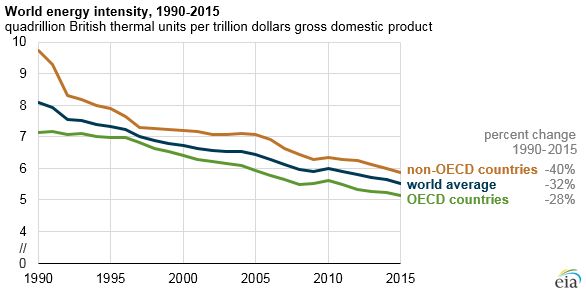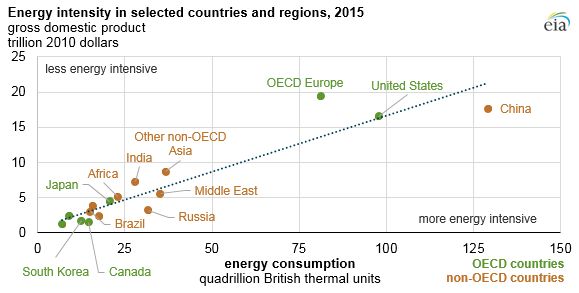It's no secret that the energy intensity of developed nations has been falling for some time. But energy consumption per unit of gross domestic product is also falling in developing nations -- and at a faster rate.
Most developing countries started out with higher levels of energy intensity, so on average their energy intensity is still higher than those in developed nations, but that gap is shrinking, according to new data from the U.S. Energy Information Administration.

Gains in industrial energy efficiency are responsible for much of the drop in overall energy intensity in OECD and non-OECD economies, as countries with heavy manufacturing tend to use more GDP per dollar. China alone cut its energy intensity by almost 20 percent between 2006 and 2010.
China’s services sector now makes up a larger portion of the economy than the industrial sector. That shift was one significant factor in China’s energy productivity increasing 133 percent in the past quarter-century.
Energy intensity should continue to drop across much of the globe in the coming years. In 2014, the U.S. and China, the nations with the largest and most energy-intense economies, pledged to joint targets to reduce carbon dioxide emissions. The White House has a goal to double energy productivity by 2030.

The non-binding target made by the U.S. and China has been overshadowed by December's Paris climate agreement, in which nearly 200 countries agreed to take steps to limit the global temperature increase to 1.5 degrees Celsius.
Much of the effort to limit the greenhouse gas emissions that drive climate change will be focused on cleaner forms of power production and increasing energy efficiency, especially in buildings, on a global scale. After the Paris agreement, for instance, more than 100 banks that manage a combined total of $4 trillion in assets called for a doubling of energy efficiency by 2030. Increasing the efficiency of industrial motors is another enormous, and largely untapped, opportunity globally.
It is not a foregone conclusion that energy intensity will continue to decline everywhere. With rapid urbanization, industrial energy efficiency will have to move forward at a steady clip just to keep pace, according to Jigar V. Shah, executive director of the Institute for Industrial Productivity. With the Paris climate agreement and the increasing availability of more energy-efficient equipment, however, it is possible that energy intensity could fall much further, even as megacities continue to grow.



